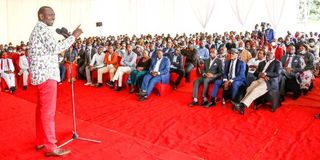BBI victory in Mt Kenya undermines Ruto’s ‘trauma bonding’ with region

Deputy President William Ruto during a meeting with professionals from Lower Eastern region at his Karen residence office in Nairobi on November 3, 2020..
What you need to know:
- For the aggressor, the Stockholm Syndrome is a survival strategy, not a trauma.
- The Tangatanga squad in the region, however, still epitomises the “Stockholm Syndrome”.
On February 23 – dubbed “Super Tuesday”– all the 10 counties in the Mt Kenya region unanimously passed the Constitution of Kenya (Amendment) Bill 2020. The triumph has dispelled the false prophecy by Murang’a Senator Irungu Kang’ata, who had sensationally written to President Uhuru Kenyatta warning that the Building Bridges Initiative (BBI) was unpopular in the region.
The passing of the Bill has stamped Mr Kenyatta’s authority as the region’s kingpin and dimmed Deputy President William Ruto’s chances of succeeding him.
The Tangatanga squad in the region, however, still epitomises the “Stockholm Syndrome”.
The concept is traced to August 23, 1973, when 32-year-old career-criminal Jan-Erik Olsson and his former prison mate took hostage four workers of the Kreditbanken in Stockholm, Sweden.
By the time the bank siege ended six days later, the victims had formed some kind of positive relationship with their captors. Indeed, when they were released, the hostages refused to testify against their captors in court and even defended them.
High-profile case
After the Stockholm heist came the high-profile case of Patty Hearst, a Californian newspaper heiress who was kidnapped by revolutionary militants in 1974, which further popularised the Stockholm Syndrome.
Patty appeared to have developed sympathy with her captors and evdn joined them in a robbery. She was eventually caught and handed a prison sentence. However, her defence lawyer, Bailey, claimed the 19-year-old had been brainwashed and was suffering from “Stockholm Syndrome”.
Another hostage, Natascha Kampusch, abducted in 1998 at the age of 10 and held in a secret cellar by her kidnapper Wolfgang Přiklopil for more than eight years, is reported to have cried when she heard her captor had died and even lit a candle for him as he lay in the mortuary!
The concept has since become influential in policy circles. From the 1970s, it has helped the US National Task Force on Terrorism and Disorder devise strategies for hostage situations.
The concept is, however, seldom used to explain the traumatic impact of widespread ethnic-based violence – such as Kenya’s 2007/2008 post-election violence – on communities and polities.
Notably, the Gikuyu Embu Meru Association (Gema) members were the main target and victims of the one-against-41 mantra that propelled the opposition’s election campaign and the ensuing post-election violence, which claimed an estimated 1,200 lives, displaced more than 500,000 people and destroyed property worth billions.
The Mt Kenya region was further petrified by the intervention of the Hague-based International Criminal Court, which commenced investigations into the responsibility for the violence and indicted six alleged perpetrators – the “Ocampo six”.
Double jeopardy
The Mt Kenya region thus faced a double-jeopardy, as the main victims of the 2007-08 post-election violence and now of the court.
A trauma bonding emerged as victims and aggressors joined hands against the ICC indictments.
A shared fear of the ICC transformed perpetrators into saviours, blurring the moral line between victims and aggressors.
The Jubilee Alliance, established in January 2013, and the Jubilee Party after 2016, evolved into a framework of trauma bonding between Mt Kenya and their assailants.
Scholars have identified four criteria for Stockholm Syndrome.
2022 elections
In the first criterion, the victims “experience something terrifying that just comes at them out of the blue. They are certain they are going to die”.
Ahead of the 2022 elections, members of the Gema nation fear they risk facing the same tragic experience as the 2007-2008 violence if they fail to elect Ruto as President.
In the second criterion, victims experience a type of infantilisation where they are turned into children. Like a child, they are unable to eat, speak or go to the toilet without permission from the “aggressor” or captors.
In the run-up to the 2022 election, Kikuyus in the Rift Valley fear that if the community does not vote Ruto as President, a cataclysmic violence will resume and they will bear the full brunt of it, unlike their kith and kin in the Mt Kenya homeland.
Kindness
In the third criterion, victims come to value small acts of kindness such as being given food, thus prompting an irrational and “primitive gratitude for the gift of life”.
Mt Kenya has again and again been reminded of Ruto’s little actions of “kindness”, including agreeing to be Uhuru’s deputy. Since 2018, the Tangatanga team has reminded the Gema nation of its debt to Ruto for supporting Uhuru in the 2013 and 2017 elections. The Mt Kenya people are afraid of being seen as unreliable and traitors.
Finally, the victims of violence “experience a powerful, primitive positive feeling towards their captor”. In this regard, “they are in denial that this is the person who put them in that situation”. They now view him as the person who is going to let them live or give them life. Driving the hustler nation ideology is a messianic spirit reflecting the Stockholm syndrome.
For the aggressor, the Stockholm Syndrome is a survival strategy, not a trauma. In Mt Kenya, BBI undermines the Stockholm Syndrome or the idea of trauma bonding between the region and the Rift Valley as the lynchpin of the Kenyatta succession politics.





